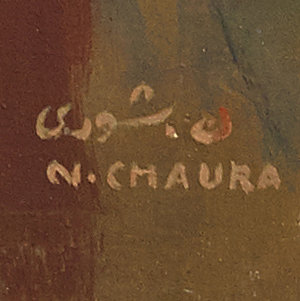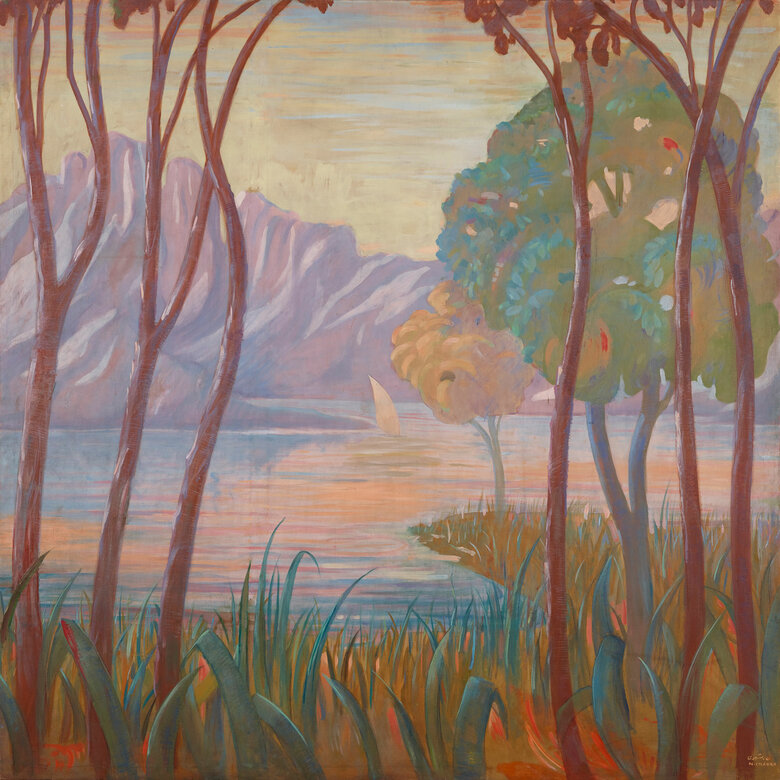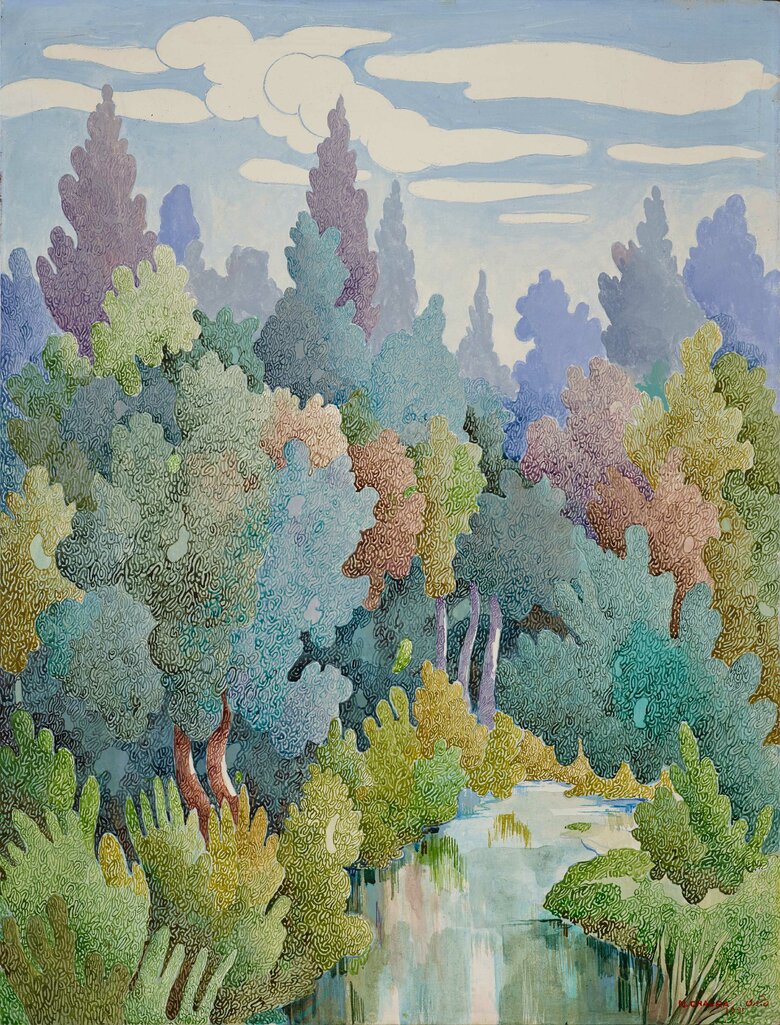Written by Mysa Kafil-Hussain “Chaura knew from the beginning of his artistic practice in the thirties that the goal of art was to express the beauty of nature” Dr Afif Behnassi[1] Nasser Chaura...


NASSER CHAURA, Syria (1920 - 1992)
Bio
Written by Mysa Kafil-Hussain
“Chaura knew from the beginning of his artistic practice in the thirties that the goal of art was to express the beauty of nature”
Dr Afif Behnassi[1]
Nasser Chaura was born in 1920 in the town of al-Muhajireen in Damascus, Syria. Chaura grew up in a bedroom facing eastwards, with the sun shining every day through his window where he would look out at the vast views of Damascus and the orchards surrounding him. These stunning scenes became part of his childhood, and would later form the warm, nostalgic paintings, which would feature heavily in his oeuvre.[2] Considered the father of Syrian Impressionism, Chaura’s career spanned over fifty years and drifted through three crucial stages: the initial impressionist stage, the abstract phase in the late 1960s, and later a “new realism” phase, in which he returned to nature.[3]
Chaura attended a prestigious high school in Damascus where he met artists such as George Khoury and began to seriously take an interest in art. At sixteen, Chaura – a keen accordionist – co-founded the National Conservatoire, where people could play music, paint and immerse themselves in creativity. Here, he was greatly influenced by artist Michel Karsha, who encouraged him to pursue his artistic talents, a suggestion which made the young creative clash with his family.[4] With prominent scholar Mohammed Kurd Ali as his uncle, and his father a well-known pharmacist,[5] Chaura’s family were keen for him to pursue what they deemed as a respectful career with prospects. Chaura rejected their views and decided to pursue art, holding his first solo exhibition in the Damascus Officers Club in 1938.[6] It was also around this time that Chaura became acquainted with a young Mahmoud Hammad (then just fourteen years old), who would visit his studio regularly to show him his work, later working closely together throughout their artistic careers.[7]
He was sent to Rome in 1939 for his studies, only to be called back to Syria shortly after due to the outbreak of the Second World War. He subsequently moved to Cairo in 1942, where he studied at the Faculty of Fine Arts and graduated in 1947. However, before moving to Cairo, Chaura was busy in Syria making connections and forming collectives. In 1940, the visual artists abandoned the Conservatoire and formed the Andalusia Forum for Painting and Literature (which lasted one year) and in 1941, Chaura, Hammad, Karsha and others established Studio Veronese, with a name inspired by Italian painter Paolo Veronese.[8] Studio Veronese was a key moment in modern Syrian art history: it was the first active hub for artists in Damascus, and became a space for them to share experiences, collaborate, and also to host other artists from abroad. Eastern European artists fleeing the war visited the studio, bringing their own brand of impressionism to the Syrians, influencing many of them in their practice, including Chaura.[9]
When Chaura returned to Damascus from Cairo in 1948, he established his own personal studio in the Abu Rummaneh district, where he would host Syrian and foreign artists regularly, including Lebanon’s Saliba Douaihy, Yugoslavia’s Mirko Pucaca and many local intellectuals. Chaura’s studio became a space for free education, collaboration, and a forum for artists to gather.[10] The early 1950s were a period of adventure and learning for Chaura: after establishing the Society for Art Lovers with Karsha in 1951, he visited Paris in 1950, gaining first-hand knowledge of European art movements, before travelling to Rome for further study. Upon his return to Syria in the mid-1950s, he began his teaching career at high schools in Damascus, educating Syrian youth in various forms of artistic practices.[11] The local art scene was gaining prominence in the late 1950s, especially with the creation of a new wing devoted to Syrian art at Damascus’ National Museum in 1956, and then the establishment of the Faculty of Fine Arts in 1960. Chaura was one of the Faculty’s founders and worked there for over thirty years, teaching students and soon-to-be celebrated artists, such as Adham Ismail, Mahmoud Jalal and Nazem Al-Jaafari.[12]
In what was a busy year, Chaura also painted Landscape in 1960, which is part of the Dalloul Collection. Portraying the Syrian countryside with a vivid warmth and manipulation of depth and perspective, Chaura creates a window into this illuminated natural world, flanked by willowy, flowing trees, and peering into a kaleidoscopic vista full of light, shadow, texture and purity of form.[13] Leading the Impressionist movement in Syria at the time, he was relatively similar to other impressionist artists in his subject and palette, but Chaura’s clear outlines and shades allowed him to stand apart in his own interpretation of the practice. In 1964, his style changed abruptly to abstraction, a phase which allowed him "the freedom to act and the freedom to form and paint", changing his medium from oil to acrylic.[14]
Alongside artists Hammad, Elias Zayat and Fateh Moudarres, Chaura established the Damascus Group (also known as the D Group) in 1965, calling for a new form of modernization in art – namely abstraction. They exhibited at Damascus’ Siwann Gallery that same year, and some works were also later displayed at the Sao Paolo Art Biennal.[15] Chaura’s artistic nature was to seek renewal and inspiration, and ten years after immersing himself in the world of abstract art, he shifted back towards representational art and returned to his beloved landscapes in the 1970s. This time, however, he seemed to find a delicate blend of impressionism and abstraction, exploring different ways to interpret the colors and shapes in his scenes: “I am still attached to the landscape, but I act freely.”[16] He continued to experiment with this approach for the rest of his life, and in the early 1990s he painted two untitled artworks (dated 1990 & 1991), which are now in the Dalloul Collection. In a return to oils, here he investigates scenes of nature in a gentle and rhythmic manner, yet simultaneously striking and bold in its shapes and tones. Textural experimentation plays a prominent role in his compositions during this phase, as can be seen in his 1991 painting, continuing to innovate and evolve his techniques right up until his passing.
Chaura died just one year later in 1992, living in his Abu Rummaneh home until his death, surrounded by ornate Damascene furniture, antiques and large windows allowing light in from his small, private garden.[17] This view undoubtedly provided the harmony and stimulation he needed for his later paintings, much like the views from his childhood home inspired him as a young and promising artist.
[1] Samar Waer, “نصير شورى".. القيم التصويرية من خلال اللون”, Esyria, June 19, 2020, http://esyria.sy/sites/code/__print.php?site=damascus&site=damascus&filename=201306191030021
[2] Al Wasat Magazine, "الوسط" تزور محترفات نصير شورى ونذير نبعة وفاتح المدرس . ثلاثة رسامين سوريين يتحولون أمامنا "مجموعة من الآهات", Al Wasat Magazine, 1993, http://daharchives.alhayat.com...
[3] Ibid
[4] Waer, “نصير شورى".. القيم التصويرية من خلال اللون”
[5] Farouk Yousif," نصير شورى الذي رأى دمشق بعيني طفل يتعلم المشي”, Al-Arab, January 31, 2016, https://alarab.co.uk/نصير-شورى-الذي-رأى-دمشق-بعيني-طفل-يتعلم-المشي
[6] Ibid
[7] Boutros Al-Maari, شورى وحمّاد: سورية في لوحة صديقين"”, Al-Araby, February 22, 2017, www.alaraby.co.uk/شورى-وحمّاد-سورية-في-لوحة-صديقين
[8] Lubna Hammad, “A History of Art Associations in Damascus During the 20th Century: From Emergence Until the First Arab Conference of Fine Arts in Damascus in 1971”, Atassi Foundation: The Journal No.8, October 5, 2020, https://www.atassifoundation.com/features/a-history-of-art-associations-in-damascus-during-the-20th-century-from-emergence-until-the-first-arab-conference-of-fine-arts-in-damascus-in-1971
[9] Yousif," نصير شورى الذي رأى دمشق بعيني طفل يتعلم المشي”
[10] Hammad, “A History of Art Associations in Damascus…”
[11] Al-Maari, شورى وحمّاد: سورية في لوحة صديقين"”
[12] Maymanah Farhat, “A creative upsurge; Syrian art today -- Part 1”, Ahram Online, June 5, 2014, http://english.ahram.org.eg/NewsContent/5/0/102937/Arts--Culture/0/A-creative-upsurge;-Syrian-art-today--Part-.aspx
[13] Christie’s, “Middle Eastern, Modern & Contemporary Art, London, 24 October 2018: Nasser Chaura – ‘Landscape’, Christie’s Auction House, 2018, https://www.christies.com/LotFinder/lot_details.aspx?intObjectID=6163321
[14] Al Wasat Magazine, "الوسط" تزور محترفات نصير شورى ونذير نبعة وفاتح المدرس . ثلاثة رسامين سوريين يتحولون أمامنا "مجموعة من الآهات"
[15] Hammad, “A History of Art Associations in Damascus…”
[16] Al Wasat Magazine, "الوسط" تزور محترفات نصير شورى ونذير نبعة وفاتح المدرس . ثلاثة رسامين سوريين يتحولون أمامنا "مجموعة من الآهات"
[17] Ibid
Sources
Farhat, Maymanah. “A creative upsurge; Syrian art today - Part 1”. Ahram Online. June 5, 2014. Accessed September 2020. http://english.ahram.org.eg/NewsContent/5/0/102937/Arts--Culture/0/A-creative-upsurge;-Syrian-art-today--Part-.aspx
Hammad, Lubna. “A History of Art Associations in Damascus During the 20th Century: From Emergence Until the First Arab Conference of Fine Arts in Damascus in 1971”, translated by Basel Jbaily. Atassi Foundation: The Journal No.8. October 5, 2020. Accessed October 2020. https://www.atassifoundation.com/features/a-history-of-art-associations-in-damascus-during-the-20th-century-from-emergence-until-the-first-arab-conference-of-fine-arts-in-damascus-in-1971
Al-Maari, Boutros. شورى وحمّاد: سورية في لوحة صديقين"”. Al-Araby. February 22, 2017. Accessed September 2020. www.alaraby.co.uk/شورى-وحمّاد-سورية-في-لوحة-صديقين
Waer, Samar. “نصير شورى".. القيم التصويرية من خلال اللون”. Esyria. June 19, 2020. Accessed September 2020. http://esyria.sy/sites/code/__print.php?site=damascus&site=damascus&filename=201306191030021
Al Wasat Magazine, "الوسط" تزور محترفات نصير شورى ونذير نبعة وفاتح المدرس . ثلاثة رسامين سوريين يتحولون أمامنا "مجموعة من الآهات", Al Wasat Magazine, 1993, http://daharchives.alhayat.com... (link no longer functioning)
Yousif, Farouk." نصير شورى الذي رأى دمشق بعيني طفل يتعلم المشي”. Al-Arab. January 31, 2016. Accessed September 2020. https://alarab.co.uk/نصير-شورى-الذي-رأى-دمشق-بعيني-طفل-يتعلم-المشي
“Middle Eastern, Modern & Contemporary Art, London, 24 October 2018: Nasser Chaura – ‘Landscape’. Christie’s Auction House. 2018. Accessed September 2020. https://www.christies.com/LotFinder/lot_details.aspx?intObjectID=6163321
CV
Selected Solo Exhibitions
1984
Ebla Gallery of Art, Damascus, Syria
1953
Syrian Art Society, Damascus, Syria
1938
Damascus Officers Club, Damascus, Syria
Selected Group Exhibitions
2024
Arab Presences: Modern Art And Decolonisation: Paris 1908-1988, Musée d'Art Moderne de Paris, Paris, France
2019
(Nothing But) Flowers, Saleh Barakat Gallery, Beirut, Lebanon
2015
Viva Syria, Boushahri Gallery, Kuwait
2014
The Young Collectors Auction, Ayyam Gallery, Dubai, United Arab Emirates
2013
Tajreed – A Selection of Abstract Art from 1908-1960, Contemporary Art Platform (CAP) Kuwait, Kuwait City, Kuwait
Selections from the Collection, Mathaf: Arab Museum of Modern Art, Doha, Qatar
1965
The Damascus Group (D Group) Exhibition, Siwann Gallery, Damascus, Syria
1952
Third Exhibition of Fine Arts, National Museum of Damascus, Damascus, Syria
Public Exhibitions
2018
Abu Dhabi Art 2018 (with The Park Gallery), Abu Dhabi, United Arab Emirates
Affiliations & Memberships
1965
Co-Founder, The Damascus Group (The D Group), Damascus, Syria
1951
Co-Founder, Society for Art Lovers, Damascus, Syria
1941
Co-Founder, Studio Veronese, Damascus, Syria
1940
Co-Founder, Andalusia Forum for Painting and Literature, Damascus, Syria
1936
Co-Founder, National Conservatoire, Damascus, Syria
Prizes
1982
Order of Merit, Damascus, Syria
1953
First Prize, General Exhibition, National Museum of Damascus, Damascus, Syria
Collections
Atassi Foundation, Dubai, United Arab Emirates
Contemporary Art Platform (CAP), Kuwait City, Kuwait
Jalanbo Collection
Mathaf: Arab Museum of Modern Art, Doha, Qatar
Ministry of Culture, Damascus, Syria
National Museum of Damascus, Damascus, Syria
Ramzi & Saeda Dalloul Foundation, Beirut, Lebanon
Press
ArtDaily.pdf
Paperblog.pdf
صحيفة تشرين • طباعة مقال.pdf
طباعة - شورى وحمّاد_ سورية في لوحة صديقين.pdf
TheNational.pdf
مئوية الفنان نصير شورى… أحد مؤسسي الفن التشكيلي السوري المعاصر – S A N A.pdf
ArtInAsia.pdf
طباعة المقال.pdf
AlArab.pdf
نصير شورى فارس الألوان الوسيمة.pdf
الوسط تزور محترفات نصير شورى ونذير نبعة وفاتح المدرس . ثلاثة رسامين سوريين يتحولون أمامنا مجموعة من الآهات ! .pdf
مدارس وأساليب لعشرات التشكيليين السوريين في دبي - جريدة الاتحاد.pdf
ما لا تعرفه عن نصير شوى ... من هو؟ سيرته الذاتية، إنجازاته وأقواله، معلومات عن نصير شورى..pdf
NASSER CHAURA Artwork
Become a Member
Join us in our endless discovery of modern and contemporary Arab art
Become a Member
Get updates from DAF
Follow Artists
Save your favourite Artworks
Share your perspectives on Artworks
Be part of our community
It's Free!
We value your privacy
TermsCookiesPrivacy Policies
Become a Member
Get updates from DAF
Follow Artists
Save your favourite Artworks
Share your perspectives on Artworks
Be part of our community
It's Free!
We value your privacy
TermsCookiesPrivacy Policies
Become a Member
Get updates from DAF
Follow Artists
Save your favourite Artworks
Share your perspectives on Artworks
Be part of our community
It's Free!
We value your privacy
TermsCookiesPrivacy Policies
Welcome to the Dalloul Art Foundation
Thank you for joining our community
If you have entered your email to become a member of the Dalloul Art Foundation, please click the button below to confirm your email and agree to our Terms, Cookie & Privacy policies.
We value your privacy, see how
Become a Member
Get updates from DAF
Follow Artists
Save your favourite Artworks
Share your perspectives on Artworks
Be part of our community
It's Free!
We value your privacy
TermsCookiesPrivacy Policies






